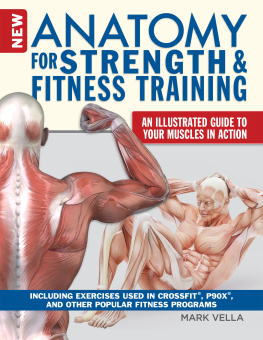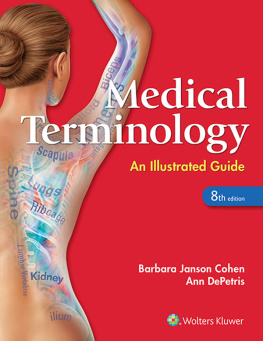Front Matter

The Secret Language of Anatomy
An Illustrated Guide to the Origins of Anatomical Terms

Cecilia Brassett Emily Evans Isla Fay
Foreword by Alice Roberts

ANATOMY BOUTIQUE BOOKS
an imprint of
Lotus Publishing, UK

North Atlantic Books
Berkeley, California
Text 2017, 2018 by Cecilia Brassett and Isla Fay. All rights reserved. No portion of this book, except for brief review, may be reproduced, stored in a retrieval system, or transmitted in any form or by any means electronic, mechanical, photocopying, recording, or otherwise without the written permission of the publisher. For information, contact Lotus Publishing or North Atlantic Books.
First published in 2017 by Anatomy Boutique Books, an imprint of Lotus Publishing and reprinted with revisions in 2018 by
Anatomy Boutique Books , an imprint of Lotus Publishing
Apple Tree Cottage, Inlands Road, Nutbourne, Chichester, PO18 8RJ and
North Atlantic Books
Berkeley, California
Text Cecilia Brassett & Isla Fay
Illustrations, Page Design & Cover Artwork Emily Evans
Printed and Bound in Malaysia by Tien Wah Press
Disclaimer
The text in the foreword is copyright of Alice Roberts and does not necessarily represent the views or beliefs of the authors.
The Secret Language of Anatomy: An Illustrated Guide to the Origins of Anatomical Terms is sponsored and published by the Society for the Study of Native Arts and Sciences (dba North Atlantic Books), an educational nonprofit based in Berkeley, California, that collaborates with partners to develop cross-cultural perspectives, nurture holistic views of art, science, the humanities, and healing, and seed personal and global transformation by publishing work on the relationship of body, spirit, and nature.
North Atlantic Books publications are available through most bookstores. For further information, visit our website at www.northatlanticbooks.com or call 800-733-3000.
British Library Cataloguing in Publication Data
A CIP record for this book is available from the British Library
ISBN 978 1 905367 79 5 (Lotus Publishing)
ISBN 978 1 62317 245 9 (North Atlantic Books)
Library of Congress Cataloging-in-Publication Data
Names: Brassett, Cecilia, author. | Evans, Emily (Medical illustrator), illustrator. | Fay, Isla, author.
Title: The secret language of anatomy : an illustrated guide to the origins of anatomical terms / Cecilia Brassett, Emily Evans, Isla Fay.
Description: Berkeley, California : North Atlantic Books, 2018. | Includes bibliographical references.
Identifiers: LCCN 2018003764 (print) | LCCN 2018001678 (ebook) | ISBN 9781623172466 (ebook) | ISBN 9781623172459 (hardback)
Subjects: | MESH: Anatomy | Terminology as Topic
Classification: LCC QM81 (print) | LCC QM81 (ebook) | NLM QS 15 | DDC 611.001/4dc23
LC record available at https://lccn.loc.gov/2018003764
For all the donors whose generosity makes our anatomy teaching programme possible
Contents
Foreword
The human body is like a wonderful, mythical landscape. Hold your hand up close to your face, palm down, and look at it carefully. Theres a row of four mountains, leading off into long ridges. You can see rivers flowing from the mountains, tributaries joining them, down to your wrist. There are lines and wrinkles there that betray the history of this place, the passage of the years etched into its surface. Under the skin there is more complexity: the epidermis lies on the deeper strata of dermis and subcutaneous connective tissue, then there are muscles, bones, nerves and deep, deep streams of blood coursing through hidden channels.
Its something wonderful to explore this landscape which seems at once so familiar and so strange, once you start to really map it and delve into it. Understanding how all these parts fit together and work together fills you with a sense of profound awe and wonder, and its not surprising that some people, over the centuries, have ended up believing that someone must have designed all this complexity. And yet its just evolved to be that way. Evolutionary biology shows how, over eons, the pattern of your body has emerged from the simplest, single-celled beginnings. If you were able to trace your family tree back far enough, youd find a unicellular organism that was the ancestor of all life on earth LUCA, the Last Universal Common Ancestor. Then, later there were other ancestors worms, fish, amphibians, reptiles, mammals, primates, apes and hominins. At last we come back to the twig of the tree of life that is modern humans Homo sapiens. And you are a perfect example of that species. As perfect as anyone else. There is no archetype. A species is the sum of all the variations that exist in all the individuals it describes. There is variation around a theme, but there are also common features that unite us all so we can create a generic atlas which provides us with a map that we can use to explore our own, unique versions of this body.
Maps are difficult to understand and to use for navigation if there are no names. It becomes very difficult to describe the detail of the landscape to someone else, the twists and turns and tributaries of its rivers, the lumps and bumps, the high ridges and deep crevasses if you have only general terms. But anatomical adventurers before us have prepared a wonderful map. Centuries indeed, millennia of exploration are encapsulated in todays atlas of the human body. And the names contained in it are wonderful. Sometimes they will describe the location of an arterial river or the winding path of a nerve; sometimes they invoke metaphors to express form; sometimes they record the name of their discoverer. Eponyms abound in anatomy, from the Islets of Langerhans and the Foramen of Luschka, to the Loop of Henle and the splenic Cords of Billroth. Theres been a move to erase these eponymous names from the official, international nomenclature of anatomy. It may be diplomatic to do so. Some eponyms differ from country to country, celebrating local discoverers. Littles area (just inside your nose, on the septum) is also Kiesselbachs area. So some anatomy books will advocate dropping the eponyms entirely. But I think the map is impoverished without them, and we lose the depth of history contained in it as well as some wonderful names.
Eponyms aside, the rest of anatomy is full of linguistic depth, detail and eccentricity. Its largely written in two languages which are no longer spoken but which have become, thanks to the pioneers who started it all, the international vocabulary of scientific discourse ancient Greek and Latin. But there are also echoes of Arabic here as well anatomical knowledge was kept alive in the Islamic world when western Europe was plunged into the Dark Ages. During the Renaissance, texts originally written in Greek, and some converted into Arabic, were translated into Latin. The anatomical language we use today isnt designed to be exclusive, the preserve of the elite. Instead, its an international language which allows anatomists and clinicians across the globe to communicate with each other. The language can seem quite foreign if youre not a classical scholar, but finding the meaning in those words unlocks fascinating secrets as well as understanding. The human body becomes a wonderland of curious details: spiderwebs inside the skull, crescent moons in the knee, a ravens beak in your shoulder, a horses tail at the end of your spinal cord, a pea inside your wrist, and vine tendrils hidden inside the scrotum.
















